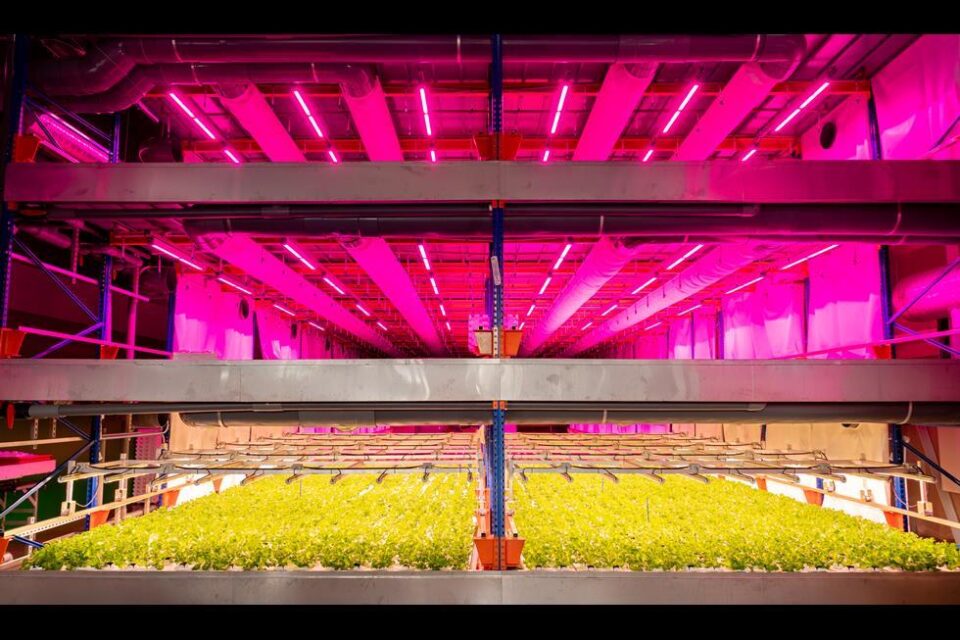“Vertical farms” – these words burst into the information space in the last couple of years. The first projects of vertical farms have already appeared in Ukraine, Moldova, Georgia and other countries of the region, although almost nothing is known about them in Uzbekistan or Tajikistan.
Andriy Yarmak, the economist at the Investment Center of the Food and Agriculture Organization of the United Nations (FAO), in his presentation “Vertical farms – do they have a future? Strategies for creating vertical farms” tried to answer the main question – what caused the interest in vertical farming and what could be the future of such projects. The online conference “Vertical Farms: Development Strategies, Business Models and Risks” was organized by the FAO and EBRD project “Climate-Smart Digital Solutions for Fruit and Vegetable Production” with the support of EastFruit and Sapienza Media.

You can watch Andriy Yarmak’s presentation below.
First, Andriy Yarmak drew attention to the fact that the idea of growing vegetables and fruits in vertical farms arose due to very objective reasons. After all, the area of agricultural land in the world is decreasing by 23 hectares every minute, and in three years approximately the same amount of productive land is lost as in the largest agricultural country in Europe – Ukraine. The population of the Earth is growing at a rate of 5.5 million inhabitants per month (two Ukraine per year!), and these people need to be fed. This means that more agricultural land is needed, not less.
It is also crucial to understand that the climate is changing, which leads to crop losses. People are less likely to want to work in difficult conditions in fields or orchards, the population is moving en masse from the countryside to the cities, and the logistics of providing them with products are becoming much more complicated.
Vertical farmers, according to Andriy Yarmak, help, at least theoretically, to partially solve these problems. True, so far there is a serious obstacle in the form of the high cost of these solutions and little experience in the development of vertical farming technologies.
However, there are commercially successful projects that are working and making money in Ukraine, Georgia, Moldova, and other countries. FAO experts conducted a study to determine what distinguishes successful projects.
According to Andriy Yarmak, successful projects, as a rule, are distinguished by systematic approaches to marketing (optimization of distribution channels taking into account the specifics of products and volume), the right choice of crops with an emphasis on uniqueness (expensive crops with a short production cycle and almost complete absence of competition), the effect synergies (when a production business is combined with another, such as a restaurant or energy business), and, most importantly, having in-house deep knowledge and experience in agronomy or technologies that are essential for vertical farming (lighting, energy, irrigation, etc.). Also, the success of the project is determined to a large extent by the place of production – it should be a city with a quite high-income level and with a developed segment of public catering and tourism (HoReCa).
“It is interesting to note that the main advantage of vertical farms is the high level of interest in them from large investors, which is also their biggest problem. After all, most large investors do not delve into the details of technology and do not bring any knowledge and experience to the project, but simply provide funding, which I call “impatient money”. They just want to get the fastest and highest return on their investment. Since vertical farming technologies and all marketing channels for products have not yet been worked out, this leads to many problems and bankruptcies in this industry on a global scale,” says Andriy Yarmak.
He lists some of the most common reasons why vertical farms fail:
– “reinvestment” – when an investor tries to invest at once in all possible elements of technologies that are not critical and only lead to an increase in the cost of the project;
– “all at once” – when a large-scale project with large production volumes is immediately created, without rolling back technologies in small areas;
– the low ratio of revenue to investment due to poorly thought-out marketing or incorrect product selection;
– a sharp increase in electricity costs compared to what was planned, since almost all projects do not generate energy on their own;
– lack of agronomic knowledge among project founders and managers of vertical farms, which cannot be replaced even by the best process automation technologies;
– “impatient money” – when the project is not given the right to make a mistake, which leads to a complete loss of investment.
Furthermore, the expert shares the example of the western region of Ukraine in choosing a crop for growing in a vertical farm. To begin with, EastFruit project experts conducted an analysis of retail prices for crops with a short growing cycle (20-50 days) in October 2022. The highest prices were for edible flowers. Further, by a wide margin, these products followed: microgreens, tarragon, fresh basil of various types, mint, spinach, baby salad mix, leafy salads, cilantro, and arugula. The lowest prices were for traditional greens – dill and parsley.
However, a high price does not guarantee large sales, so it is important to include the market size factor in the analysis as well. As expected, the cheapest products had the highest rates here. However, the optimal ratio of price and market volume was observed for such products as tarragon, basil, and mint, as well as various types of salads. However, it all depends on the scale of the project, and everyone should make a choice based on their own business parameters.
Read also: The issues of plant protection from pests and diseases are crucial in vertical farming
Naturally, this is only the first step in determining what to grow. Further, it is necessary to engage in work with representatives of the HoReCa segment to understand unique and most valuable positions. It is important to understand which of the positions has a high share of imported products (which means that transport is expensive + there may be freshness and quality issues). It is also important to understand which types of food have the most problems with freshness and taste as a delicious fresh salad can be the reason why consumers return to a particular restaurant if it receives products daily from a vertical farm located nearby. Well, many ethnic restaurants may require a wide range of greens that simply cannot be found on the market.
By the way, the opposite is also true – if you offer the market a wide range of greens all year round, this can help restaurants expand the menu by introducing salads and dishes that the restaurant could not offer before. An example of this approach is the Space Farms vertical farm in Georgia, which is located right in the restaurant.
Of course, vertical farming technologies are now just beginning to develop, which limits the range of crops that can be grown there. However, as technologies become cheaper and improved, new opportunities will emerge. Therefore, vertical farms are both the future and, at the same time, a really profitable and sustainable business with a reasonable approach to it.
The use of the site materials is free if there is a direct and open for search engines hyperlink to a specific publication of the East-Fruit.com website.




